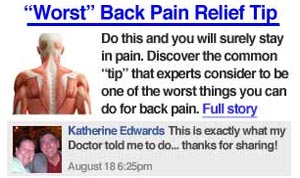Muscle imbalances create uneven pressure and wear and tear by pulling ligaments, bones, and joints out of place... especially, the pelvis and spine. For example, extended periods of sitting leads to an imbalance between the hip flexors (muscles in the front of the hip/upper thigh) and the glutes... and this imbalance pulls your pelvis and spine out of place.
The good news, when the body is close to balanced, there’s little or no uneven pressure and the compression on discs is dramatically reduced. So what does this mean? It means years and years of healthy discs... and that means no back pain.
Degenerative Disc Disease Symptoms
The most common symptoms are back or neck pain. Many people have no pain, while others with the same degree of disc damage have severe pain that limits their activities. An affected disc in the neck area may result in neck or arm pain, while one in the lower back may bring pain to the back, buttocks, or leg. The pain often gets worse when you bend, reach, or twist. In some cases, there may be numbness or tingling in your leg or arm. Loss of bowel or bladder control is deemed a medical emergency, so you should get to the emergency room as quickly as possible if either of these things happens to you.
Degenerative disc disease is diagnosed with a medical history and physical examination. During the exam, your doctor should check for range of motion and pain associated with the affected area, as well as any tenderness, numbness, tingling, or weakness. Your doctor should also ask about underlying conditions, such as fractures, tumors, and infection. If this examination shows no signs of a serious condition, imaging tests - such as an X-ray - are probably unnecessary.
Degenerative Disc Disease Treatment
Common treatments include cortisone injections, non-steroidal anti-inflammatory drugs (NSAIDs), hot packs, ultrasound, electrical stimulation, and therapeutic exercises. Surgery is also an option, with the two main goals being to take pressure off the nerve and stabilize the joints.
 Most traditional treatments fail because they simply address the symptoms and do not address the cause of the condition. Your degenerated disc is a physical problem, and it requires a physical solution. There are no pills or injections that can create postural balance in your body, which is what is necessary to reduce the pressure on the nerve.
Most traditional treatments fail because they simply address the symptoms and do not address the cause of the condition. Your degenerated disc is a physical problem, and it requires a physical solution. There are no pills or injections that can create postural balance in your body, which is what is necessary to reduce the pressure on the nerve.
The principles of Muscle Balance Therapy™ address both the pain of a degenerative disc and the root of the problem - in other words, what's causing the pressure in the first place. Through strategic body assessments, your individual muscle imbalances can be identified. Once that is done, a very targeted corrective program can be designed for your specific needs.
To learn more about how you can get lasting relief from your Back Pain by using Muscle Balance Therapy™, we suggest you read the latest copy of our Back Pain Relief Guide, simply Fill out the form below now and you'll receive free instant access.
To learn more about muscle imbalances and how eliminating them will improve your condition and prevent further deterioration of your discs, we recommend you watch our Lose the Back Pain video... in just 20 minutes you WILL be able to identify the specific muscle imbalances you have AND it will show you step-by-step, exactly what you need to do. We know you are sick and tired of the back pain and useless treatments, so order your copy now and we’ll rush you your order so you can get started right away.
About Lose the Back Pain System:
- The four "physical dysfunctions" that are responsible for over 90% of all back pain
- Simple "self assessments" you can perform in just minutes, anywhere to help you pinpoint which dysfunctions you have
- 4 Step-by-Step "Corrective Action Plans" that show you exactly what you need to do to balance your body and eliminate your back pain
- the facts about back pain and other conditions like sciatic nerve pain and arthritis
- how to strengthen your lower back and abs to prevent injuries
>> Click here to order Jesse Cannone's Lose The Back Pain System and eliminate your back pain!


